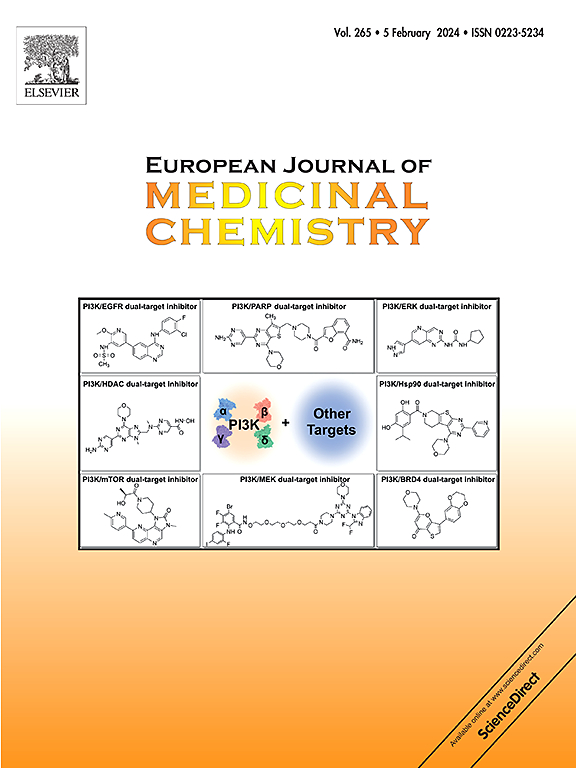甲硝唑-熊去氧胆酸双功能抗菌药物:对抗艰难梭菌感染和预防复发的有希望的策略
IF 6
2区 医学
Q1 CHEMISTRY, MEDICINAL
引用次数: 0
摘要
目前治疗艰难梭菌感染(Clostridium difficile infection, CDI)的药物,如万古霉素和甲硝唑等,由于破坏肠道菌群平衡,经常导致严重复发,因此迫切需要新的化学实体来治疗CDI。胆汁酸,如UDCA,已被证明可以抑制艰难梭菌的生长和孢子萌发,并调节肠道菌群的结构。本研究涉及八种胆汁酸-甲硝唑杂合体的合成。其中,最有希望的杂种scut - 1-2能有效杀死艰难梭菌的营养细胞,最低抑制浓度(MIC)为0.06 ~ 0.50 μg/mL,并能抑制孢子的体外萌发。SCUT1-2的绝对生物利用度(F = 56.8%)表明,大约一半的SCUT1-2被全身吸收,而相当一部分以其原始形态留在胃肠道,为其在体内有效作用奠定了坚实的基础。SCUT1-2能有效缓解CDI引起的小鼠体重减轻和腹泻症状,有效降低炎症因子的相关表达,优于甲硝唑。此外,SCUT1-2通过杀死艰难梭菌细胞和调节肠道菌群的组成和结构,在降低CDI小鼠死亡率和疾病症状方面表现出良好的治疗效果。值得注意的是,scut - 1-2可以有效预防复发性CDI。这项工作为CDI治疗的发展提供了潜在的临床指导,并突出了混合药物作为一种新策略。本文章由计算机程序翻译,如有差异,请以英文原文为准。

Metronidazole-ursodeoxycholic acid bifunctional antibacterial: A promising strategy to combat Clostridium difficile infection and prevent recurrence
Current treatments against Clostridium difficile infection (CDI), such as vancomycin and metronidazole, frequently lead to severe recurrence due to disruption of gut microbiota balance, which results in a pressing need for new chemical entities to treat CDI. Bile acids, such as UDCA, have been demonstrated to inhibit the growth and spore germination of C. difficile, and regulate the structure of the intestinal flora. This study involved the synthesis of eight bile acid-metronidazole hybrids. Among them, the most promising hybrid, SCUT1-2, effectively killed the vegetative cells of C. difficile with a minimum inhibitory concentration (MIC) of 0.06–0.50 μg/mL, and inhibited spore germination in vitro. The absolute bioavailability of SCUT1-2 (F = 56.8 %) indicated that approximately half of SCUT1-2 was absorbed systemically, while a considerable portion remained in the gastrointestinal tract in its original form, laying a solid foundation for its effective action in vivo. SCUT1-2 could effectively alleviate the symptoms of weight loss and diarrhea in mice caused by CDI and effectively reduce the relevant expressions of inflammatory factors, outperforming metronidazole. Furthermore, SCUT1-2 demonstrated a favorable therapeutic effect in reducing mortality and disease symptoms in CDI mice by killing C. difficile cells and regulating the composition and structure of the intestinal flora. Notably, SCUT1-2 could effectively prevent recurrent CDI. This work provides a potential clinical lead for the development of CDI therapies and highlights hybrid medication as a new strategy.
求助全文
通过发布文献求助,成功后即可免费获取论文全文。
去求助
来源期刊
CiteScore
11.70
自引率
9.00%
发文量
863
审稿时长
29 days
期刊介绍:
The European Journal of Medicinal Chemistry is a global journal that publishes studies on all aspects of medicinal chemistry. It provides a medium for publication of original papers and also welcomes critical review papers.
A typical paper would report on the organic synthesis, characterization and pharmacological evaluation of compounds. Other topics of interest are drug design, QSAR, molecular modeling, drug-receptor interactions, molecular aspects of drug metabolism, prodrug synthesis and drug targeting. The journal expects manuscripts to present the rational for a study, provide insight into the design of compounds or understanding of mechanism, or clarify the targets.

 求助内容:
求助内容: 应助结果提醒方式:
应助结果提醒方式:


